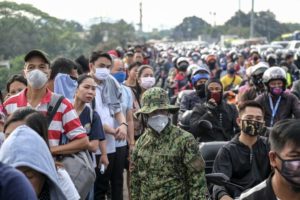By Dr. Jesus P. Estanislao
Chairman, Center for Excellence in Governance
This article was first published in the May 2020 Special Feature of Staff Memos, a publication of the UA&P School of Economics.
Within only a quarter after the pandemic’s assault, economies that had been running at virtually full employment were suddenly reporting unemployment rates of as high as 15% to 20%, and still rising. China, a growth powerhouse, saw its GDP rate plunging to negative territory to as high as 6.8%. And one of the two parties in the US that had been a paragon advocate for fiscal discipline and public spending restraint turned around to pass speedily a stimulus spending bill of US$2trillion, with more bail-out packages being rushed and legislated.
The list of economic challenges has lengthened considerably; and thus instead of alluding to a mere deep recession, economic analysts are touting up a depression of uncertain length. Even the usual prophets of boom may need to take a second and third look at their crystal ball, since all the basic economic trends are foreshadowing an economic gloom instead. Indeed, if economic realities and prospects in developed economies are looking so dismal, how much worse can they get for developing economies such as the Philippines?
No one really knows, and thus there is a heavy cloud of uncertainty that hangs during the extended lockdown and in the aftermath of its eventual lifting. Given such uncertainty, how many economies and polities think through the immediate homework of having to ensure economic survival and maintain sociopolitical solidarity?

MEGA-TRENDS REINFORCED BY THE PANDEMIC
The London-based Economist (April 11, 2020) has put forward three mega-trends that have been reinforced by COVID-19. Already shaping up over a few years, these mega-trends have now been firmed up by the pandemic:
- Central governments, mainly because they have to respond to the economic consequences of COVID-19 through massive stimulus spending, have become much bigger and taken on more power. In an emergency, governments assume more power and authority, and these would need to be backed up by big bucks. As governments spend, big business conglomerates benefit: they are in the best position to take advantage of massive government spending. However, care and diligence will have to accompany our reading of “big government” and “big business”: not all government units are awash with funds to spend (indeed, many government agencies are cash-starved); and not all big business corporations are raking in huge profits (most are grappling with issues of continuity and future strategic positioning). But those corporations in the right sectors such as pharma, food delivery, IT and other specialized niches are doing very well.
- The process of globalization that has been going on for a few decades has been stalling, and risk management considerations have been bringing up the need for alternative global supply chains with less of a China footprint. For reasons peculiar to the US, the old global order which the US dominated and which had facilitated the attainment of higher levels of prosperity for the global economy as a whole has been fraying. In addition, the risks from disruptions in the functioning of the global supply chain—occasionally heightened by US-China trade frictions—have led to a scramble for building up alternative global supply chains with lesser reliance on China. These alternative supply chains may be shorter; they may be less cost-effective; nonetheless, as alternatives, they have become indispensable. COVID-19 has simply added more fuel to the fire that has already been burning with respect to globalization and the rush for alternative global supply chains.
- The 4th Industrial Revolution has already been heralded by the World Economic Forum. This revolution features increased digitalization. It involves a massive intrusion of digital technology into the way we live, work, and learn. With the imposition of social distancing and lockdown measures, in the wake of COVID-19, digitalization is no longer an option. It has become an imperative: it is the only option for meetings, for most work arrangements, and for learning. No longer would traditional ways of sharing ideas and information be feasible; in many instances, they are outright prohibited.

If these mega-trends continue to have a firmer grip on the circumstances within which we have to live, work, and learn, it is imperative to look at them in the eye and to draw ideas on how we should move forward.
IMPLICATIONS FROM THE MEGA-TRENDS
As we scan the current situation and explore the prospects ahead, we cannot focus only on the depression, unemployment, falling GDP, and the high rate of business failures. We should also follow “the big money”: where it flows with massive government deficit spending. Moreover, the specific sectors and the business conglomerates, which benefit from the stimulus spending packages, would provide at least a few bright lights and zones of opportunity.
A few of those government agencies with millions of bucks to spend can take advantage of the COVID-19 pandemic in order to build better systems and stronger capabilities to prepare for future pandemic stresses and strains. The business conglomerates doing well during this crisis have a splendid opportunity not only to become bigger but also become stronger and more sustainable for the longer term. The hat-trick that many of us can play is how to strike a meaningful partnership with these select government units and business conglomerates.
There are a few more strategic challenges that these few government agencies and business conglomerates would need to address together. These challenges arise from the de-globalization trend and the search for alternative global supply chains. As the current COVID-19 crisis has sharply defined, we cannot—and should not—put all our eggs in the globalization basket. We absolutely need to have a domestic supply chain that would safeguard our national security, which demands our ability to supply the basic needs of our people: food; medicine; shelter; clothing; and education. Furthermore, we can tap into the frantic search for alternative global supply chains and offer a few of our regions as spokes to these new supply chains. In either case, we need to pull together government, business, and civil society to create a framework and systematically execute a national “basic needs” supply strategy. It will also do well to wage a pro-active campaign for some of our regions to become reliable “spokes” in the alternative supply chains (as an alternative to China). This is a massive undertaking, one which we should immediately keep ourselves busy with. Indeed, this is much better and more positive than sulking and counting our losses from COVID-19.

Finally, what about the challenge of an all-intrusive digitalization? Instead of resisting it, we should embrace it. Instead of hanging on to our traditional, old-fashioned ways of doing things—of living, working and learning—let us take the big leap across the digital divide and readjust as quickly and systematically as possible. No more big classes, big conferences, big seminars but to experiment on digital alternatives. These digital alternatives can open new pathways by which to reach more people and to leave a deeper impact not only on individuals but on organizations (institutions and enterprises) as well. Fortunately, much of the digital technology is already in place; we may have to make significant adjustments in adapting the appropriate technology to suit our needs.
These implications—in broad strokes—point to various opportunities that need to be seized if we are to reverse a dreadful crisis into finding pots of gold. Depending on the circumstances of our respective organizations, we should look for specific niches within the new horizons, drawn from the implications of the mega-trends that COVID-19 has reinforced.
A PANORAMA OF OPPORTUNITIES
Big government and big business whose scale of operations and size of resources have grown enormously would have an opportunity to address the issues that have confronted them during the pandemic. For example, our Department of Health and the array of hospitals—either directly under it or more broadly associated with it—may need to face up to the challenge of systemic cooperation and coordination in providing health care services to our people, especially in light of the universal health care law.
Both DOH and the wide array of hospitals at various levels face the challenge of working together as one systemic whole; they need to hasten the assessment of their governance and transformation programs and to ensure the strategic outcomes of these programs now and in the foreseeable future. The same holds true for big business conglomerates that benefit hugely from the massive increase in public spending. What should they focus on in order to build not only a bigger but stronger and more sustainable enterprise? That enterprise should also be wired to the newer demands of the economy and polity, and then look for ways and means by which it can help make a positive difference. These conglomerates should embrace the discipline of corporate governance and maximize its use for their benefit.

Big government departments and big business enterprises, which observe the discipline of governance, necessarily have to think systemic, long-term, and in ways that are wide open to the newer demands of the economy and polity. In close solidarity, they can map out a long-term national strategy for basic needs that can be met more autonomously by domestic supply chains, preferably within regions contiguous to each other. We may not be able to supply all the food and medicine we may absolutely need in times of serious disruption: but we should be in a position to provide for a reasonable percentage of such needs.
This is an enormous undertaking, which opens new business opportunities for many other economic players, including SMEs. The same holds true for a possible national strategy that aims to have some regions of our country as spokes of new regional-global supply chains to serve as alternatives to the heavily-dependent-on-China supply chains. As we go more granular into the details of both a national basic needs strategy and positioning some regions as integral spokes of alternative global supply chains, we shall find that the execution of such strategy should have to be multi-sectoral: it should open to many more players, including smaller local government units and smaller business enterprises.
Multi-sector participation, involving local government units and business enterprises smaller in scale than the big business conglomerates, would make specific demands upon them; and these demands would have to be met mainly through newer digital technology. Let me cite three possible demands:
- As the World Economic Forum (Schwab, 2019) has indicated, operating within a more fully digitalized environment, individuals in any organization—whether they are government institutions or business enterprises—will need to step up with their contextual, emotional, social, and physical intelligence. In other words, individuals will have to build themselves up as the ultimate governance asset of the organization. And all this “build-up” or formation will have to bank on exclusively digital means: faster; cheaper, and more convenient.
- As the ISA (Estanislao, 2016) experience has shown, organizations build themselves up mainly by banking upon small working teams that are tasked to become the ultimate performance delivery units for the organization. Teams are small, nimble, more manageable and cohesive. As the basic constitutive units of an organization whose internal value chain is efficient and effective, they can be made to carry a much heavier brunt of contributing to the attainment of the strategic priorities in the organization’s transformation road map.
- And as Michael Porter (Porter and Kramer, 2011) has argued in favor of strengthening external value chains, organizations themselves would need to become pro-active participants in the process of transforming wider areas or even whole regions, and of securing a higher-level of competitiveness for an entire industry or sector, or at least of a group of well-interconnected external stakeholders.

The panorama of new opportunities, framed by COVID-19, is very broad. It calls for a lot of work, but also some radical adjustments in the way we think, work, live, and learn. Mind-sets will have to change along with the digital technology that imposes newer ways of going about our normal business.
A POT OF GOLD IN THE HORIZON
Although life after the lockdown imposed by COVID-19 will be very challenging, it will not be without new opportunities. After all, life must go on; except that life—as shaped by the mega-trends reinforced by COVID-19—will be quite different from the “old normal”.
We all need to make radical adjustments. Big government and big business will have an opportunity as well as the imperative to think longer-term and more systemic. New strategic priorities—such as a national basic needs strategy and participation in alternative global supply chains—will have to be fleshed out and eventually pursued. And every organization—whether public institution or business enterprise—will have to meet the new demands imposed by a more fully digitalized work and life environment.
There is a lot of homework to do. And for those driven by a creative and an entrepreneurial spirit, and those willing and able to get through these radical adjustments, they will certainly discover pots of gold at the end of the rainbow. #
REFERENCES:
Estanislao, J. (2016) It Can Be Done. Institute for Solidarity in Asia, Manila.
Porter M. and Kramer M. “Creating Shared Value” In Harvard Business Review, January-February 2011. Boston, Massachusetts, USA.
Schwab, K. (2016) The Fourth Industrial Revolution. World Economic Forum, Davos, Switzerland.
—
Banner photo by Dylan Ferreira on Unsplash.
Related articles:
The COVID-19 international timeline
10-Word Story (How is this pandemic changing you?)
How to fill time when it is best to stay indoors
How to beat stress in times of quarantine
Leave a Reply